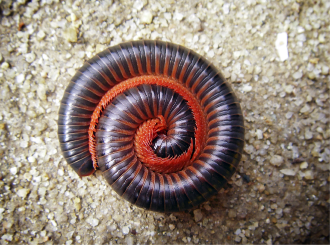Diplopoda: Difference between revisions
mNo edit summary |
mNo edit summary |
||
| Line 26: | Line 26: | ||
|} | |} | ||
Diplopods, more commonly known as millipedes, are long, segmented [[invertebrates]] belonging to the subphylum [[Myriapoda]]. The Latin meaning of the name Diplopoda, 'having double feet', refers to the distinctive features of millipedes, in which they possess two pairs of legs per body segment <ref name="Merriam">Merriam-Webster. n.d. Diplopoda. https://www.merriam-webster.com/dictionary/Diplopoda</ref><ref name="Ohio">Hennen, D. & Brown, J. n.d. Millipedes of Ohio Field Guide. Ohio Division of Wildlife. chrome-extension://efaidnbmnnnibpcajpcglclefindmkaj/https://dam.assets.ohio.gov/image/upload/ohiodnr.gov/documents/wildlife/backyard-wildlife/Millipedes%20of%20Ohio%20Pub%205527.pdf</ref>. While their common name means 'thousand feet', most millipede species possess 47 to 197 pairs of legs<ref name="Tohono">Tohono Chul. n.d. Millipede Facts. chrome-extension://efaidnbmnnnibpcajpcglclefindmkaj/https://tohonochul.org/wp-content/uploads/2020/07/Millipede_Facts_Worksheet.pdf</ref>. However, in 2020, the first millipede species with over one thousand legs was discovered in Western Australia — ''Eumillipes persephone'', with 1,306 legs<ref name="Marek">Marek, P., ''et al.'' (2021). The first true millipede—1306 legs long. ''Scientific Reports''. https://www.nature.com/articles/s41598-021-02447-0</ref>. | Diplopods, more commonly known as millipedes, are long, segmented [[invertebrates]] belonging to the subphylum [[Myriapoda]]. The Latin meaning of the name Diplopoda, 'having double feet', refers to the distinctive features of millipedes, in which they possess two pairs of legs per body segment <ref name="Merriam">Merriam-Webster. n.d. Diplopoda. https://www.merriam-webster.com/dictionary/Diplopoda</ref><ref name="Ohio">Hennen, D. & Brown, J. n.d. Millipedes of Ohio Field Guide. Ohio Division of Wildlife. chrome-extension://efaidnbmnnnibpcajpcglclefindmkaj/https://dam.assets.ohio.gov/image/upload/ohiodnr.gov/documents/wildlife/backyard-wildlife/Millipedes%20of%20Ohio%20Pub%205527.pdf</ref>. While their common name means 'thousand feet', most millipede species possess 47 to 197 pairs of legs<ref name="Tohono">Tohono Chul. n.d. Millipede Facts. chrome-extension://efaidnbmnnnibpcajpcglclefindmkaj/https://tohonochul.org/wp-content/uploads/2020/07/Millipede_Facts_Worksheet.pdf</ref>. However, in 2020, the first millipede species with over one thousand legs was discovered in Western Australia — ''Eumillipes persephone'', with 1,306 legs<ref name="Marek">Marek, P., ''et al.'' (2021). The first true millipede—1306 legs long. ''Scientific Reports''. https://www.nature.com/articles/s41598-021-02447-0</ref>. They bear a head with one pair of antennae, a pair of simple eyes known as ocelli, and modified maxillae which are used as chewing mouth parts. | ||
== Characteristics and Morphology == | == Characteristics and Morphology == | ||
Most millipedes are long and either cylindrical or flat in shape. However, pill millipedes, belonging to the family Glomeridae, are stout and resemble isopods<ref name="Pill">Australian Museum. (2020). Pill Millipedes. https://australian.museum/learn/animals/centipedes/pill-millipedes/</ref>. | Most millipedes are long and either cylindrical or flat in shape. However, pill millipedes, belonging to the family Glomeridae, are stout and resemble isopods and, in similar fashion, can roll into a ball when disturbed.<ref name="Pill">Australian Museum. (2020). Pill Millipedes. https://australian.museum/learn/animals/centipedes/pill-millipedes/</ref>. Most millipede species have hard, calcareous exoskeletons that protect them from predators and large forces faced when burrowing in soil<ref name="Borrell">Borrel, B. (2004). Mechanical properties of calcified exoskeleton from the neotropical millipede, ''Nyssodesmus python''. ''Journal of Insect Physiology''. https://www.sciencedirect.com/science/article/abs/pii/S0022191004001593</ref>. Millipedes may roll into a spiral as a defense mechanism, where their harder exoskeleton on the top of each of their body segments, or tergites, protect their legs and more vulnerable underside. Millipedes lack a waxy layer on their epicuticle, making them vulnerable to desiccation<ref name="Coleman">Coleman, D.C., M.A. Callaham Jr., & D.A. Crossley Jr. (2017). ''Fundamentals of Soil Ecology - 3rd Edition''. Academic Press.</ref>. | ||
| Line 38: | Line 38: | ||
== Distribution == | == Distribution == | ||
== References == | |||
Revision as of 10:50, 3 April 2025
 | |
| Kingdom: | Animalia |
|---|---|
| Subkingdom: | Bilateria |
| Infrakingdom: | Protostomia |
| Superphylum: | Ecdysozoa |
| Phylum: | Arthropoda |
| Subphylum: | Myriapoda |
| Class: | Diplopoda |
Diplopods, more commonly known as millipedes, are long, segmented invertebrates belonging to the subphylum Myriapoda. The Latin meaning of the name Diplopoda, 'having double feet', refers to the distinctive features of millipedes, in which they possess two pairs of legs per body segment [2][3]. While their common name means 'thousand feet', most millipede species possess 47 to 197 pairs of legs[4]. However, in 2020, the first millipede species with over one thousand legs was discovered in Western Australia — Eumillipes persephone, with 1,306 legs[5]. They bear a head with one pair of antennae, a pair of simple eyes known as ocelli, and modified maxillae which are used as chewing mouth parts.
Characteristics and Morphology
Most millipedes are long and either cylindrical or flat in shape. However, pill millipedes, belonging to the family Glomeridae, are stout and resemble isopods and, in similar fashion, can roll into a ball when disturbed.[6]. Most millipede species have hard, calcareous exoskeletons that protect them from predators and large forces faced when burrowing in soil[7]. Millipedes may roll into a spiral as a defense mechanism, where their harder exoskeleton on the top of each of their body segments, or tergites, protect their legs and more vulnerable underside. Millipedes lack a waxy layer on their epicuticle, making them vulnerable to desiccation[8].
Reproduction and Life Cycle
Diet and Feeding Behaviors
Distribution
References
- ↑ Integrated Taxonomic Information System (ITIS). n.d. Diplopoda. https://itis.gov/servlet/SingleRpt/SingleRpt?search_topic=TSN&search_value=154409#null
- ↑ Merriam-Webster. n.d. Diplopoda. https://www.merriam-webster.com/dictionary/Diplopoda
- ↑ Hennen, D. & Brown, J. n.d. Millipedes of Ohio Field Guide. Ohio Division of Wildlife. chrome-extension://efaidnbmnnnibpcajpcglclefindmkaj/https://dam.assets.ohio.gov/image/upload/ohiodnr.gov/documents/wildlife/backyard-wildlife/Millipedes%20of%20Ohio%20Pub%205527.pdf
- ↑ Tohono Chul. n.d. Millipede Facts. chrome-extension://efaidnbmnnnibpcajpcglclefindmkaj/https://tohonochul.org/wp-content/uploads/2020/07/Millipede_Facts_Worksheet.pdf
- ↑ Marek, P., et al. (2021). The first true millipede—1306 legs long. Scientific Reports. https://www.nature.com/articles/s41598-021-02447-0
- ↑ Australian Museum. (2020). Pill Millipedes. https://australian.museum/learn/animals/centipedes/pill-millipedes/
- ↑ Borrel, B. (2004). Mechanical properties of calcified exoskeleton from the neotropical millipede, Nyssodesmus python. Journal of Insect Physiology. https://www.sciencedirect.com/science/article/abs/pii/S0022191004001593
- ↑ Coleman, D.C., M.A. Callaham Jr., & D.A. Crossley Jr. (2017). Fundamentals of Soil Ecology - 3rd Edition. Academic Press.
- ↑ Marek, P. et al. (2014). A species catalog the millipede family Xystodesmidae (Diplopoda: Polydesmida). Virginia Museum of Natural History. https://www.researchgate.net/publication/267810849_A_species_catalog_the_millipede_family_Xystodesmidae_Diplopoda_Polydesmida